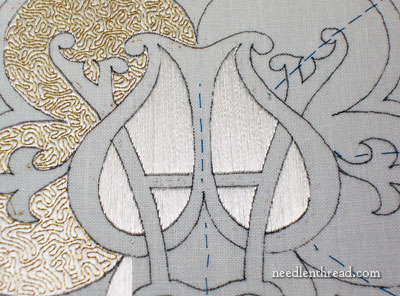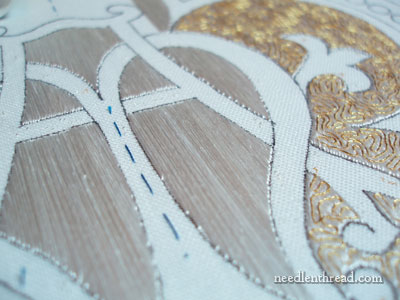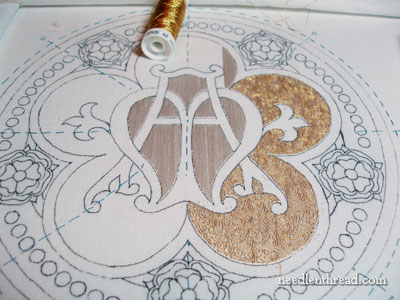Lately, I’ve been stitching upside-down.
(How’s the visual on that? Not so good?)
I am not upside-down – but my design is.
Working with the design upside-down for the area I’ve been filling with silk, I’ve found that I’ve been stitching much faster because the reach to the area I’m working is not quite as far.
Depending on the embroidery project, you’re perfectly justified in turning your design upside-down. There are some embroidery techniques where doing so wouldn’t work so well, but with this type of flat stitchery, to avoid reaching far to the top of the design, it’s much easier just to turn the frame 180 degrees.

My progress so far: the center of the monogram is filled with silk. Now it’s just a matter of couching the gold over the silk to hold all those little strands in place.

The more I stitch with Au Ver a Soie’s Soie Ovale, the more I love, love, love, love, love this thread. It is really unlike any other flat silk on the market. The closest thing that comes to it is the Japanese silk used for Japanese embroidery, but I think Soie Ovale has a bit more body to it. It is a super nice thread!
Flat silk is fiddly to work with, but once you get the hang of it, it’s not as bad as it seems. Two things will help a stitcher use flat silk with ease: 1. the manner in which the needle is held and the stitch taken; and 2. The equipment used when stitching.
When you first encounter flat silk and take a stab at stitching with it, you might find that the silk snags on the edges of your fingers where you hold the needle, and just about everywhere else that it possibly could snag. The key here is control – controlling the silk by the way the needle is held and the way the stitch is taken. After the first few stitches, you’ll discover that keeping the needle perpendicular to the fabric when the stitch is taken makes all the difference in the world when stitching with this type of thread. Straight up and down with the needle, and many “problems” of working with flat silk are instantly solved. The thread must also be kept under control, and this is best done by the tools you need when working with flat silk.
The first tool – the flat-silk-embroiderer’s Best Friend – is the laying tool. The laying tool keeps tension on the silk as the stitch is taken, which keeps all the tiny filaments of silk together during the progress of the stitch, and this keeps the silk from bunching up or knotting as the thread is pulled through the fabric. The laying tool also keeps the filaments of silk lying flat and parallel, so that the whole thread lies smooth and covers well.
Using a laying tool pre-supposes another tool: a stand for the embroidery frame. This type of thread requires that both hands are free for stitching – one to work the needle and thread and the other to manage the laying tool. So a needlework stand (or at least some method of securing your frame so that both hands are free) is essential.

Progress from afar.
I’m really enjoying this part of the Medallion project. I love the materials I’m working with and I really love this technique. In a sense, it is very meditative work. There are no complicated stitches or techniques to confuse or muddle things up here; it’s just a matter of working steadily. So, some good music in the background (yes, Christmas music – I’m a Christmas Music Fanatic, I’m afraid) and … ahhhh! … Perfect Bliss!
If you’d like to follow this project from its beginnings, you’re welcome to visit the Medallion Project index, where you’ll find every article listed chronologically so that you can follow along step by step.
Have a wonderful weekend!
If you’d like access to all the tips and techniques discussed in the Medallion Project, including complete step-by-step coverage of the Tudor-Style Rose, conveniently collected in one document, interlinked, referenced, and indexed, why not add the Marian Medallion Project e-book to your library? It’s packed full of all kinds of embroidery tips for undertaking a project like this, all in a convenient electronic format for easy searching.







I am glad you are enjoying your project!
Deb
Que dire!!!! Tout est merveilleux!!! Quel talent !!! Félicitation!!!!
Mary, maybe you could provide some enlightenment and the difference between using a regular laying tool and a mellore? I don’t have very much experience with metallic threads, but I’m learning.
Mary: Please, please,PLEASE make a video of your hands showing “the manner in which the needle is held and the stitch taken” while laying the silk. I always snag flat silk and would love to see if my technique is part of the problem (and I do use a stand and a laying tool). Again, I marvel at how straight and parallel your strands lie; I did have an “aha!” moment yesterday when you explained “stair-stepping” the threads and will make sure I am doing that the next time. From one Christmas Music Fanatic to another, happy listening while stitching! Janet.
My goodness, Mary, that is stunning. I’m amazed at how gold the medallions appear from a distance because the vermicelli looks quite open close up. You don’t have to sell me on flat silk, I just love it. And I also find laying a foundation of flat silk a calming meditative pass time.
Another thing I’ve noticed when working on something from a new angle (not just needlework either)- I seem to start focusing on what I’m actually doing, not the mental image of the intended result. It’s hard to explain.
Thanks for the nice illustrations on keeping threads parallel. Any tips for when the threads are not parallel with the fabric threads or the fabric threads are not visible, say velvet or felt?
Another group of people who stitch upside down are the “little hands” of the haute couture houses, when beading net.
It’s funny your blog today about stitching upside down. I’m just working on my first project, and was not able to reach part of the design in the frame. I had to turn it upside down to reach it easily. It is kind of fun!
It reminds me of the days from design school where the instructor had us work on our drawings upside down. At first it was a challenge, but then something clicked, and it worked like a charm. One tends to forget what they are doing and actually focus on what they see. The drawings were always much better when worked in this manner.
Thank you so much for sharing. I look forward to trying the flat silk. Your clear and detailed instructions are sure to make it a success!
(PS – I am playing all the classic Christmas DVD’s while stitching!)
I don’t use a laying tool. For me it slows down the work. I do however always work with both hands – dominant hand on top, other underneath. I work a lot with flat silk that I purchase directly from India (undyed) which I then dye myself. I find my biggest assets in working with flat silk are a good hand cream and a thread conditioner, which in Australia sells under the name Thread Heaven.
Also, forgot to say that I love this technique of couching gold thread over threads laid in satin stitch. I’m going to try and incorporate it into one of my artworks. Thanks.
silkandcolour.blogspot.com
Hi Mary,
I would love to know what some of your favorite Christmas music is. I love it too and I’m always looking for more ideas. I prefer traditional for the most part but I’m open to something new, if it comes highly recommended. Any suggestions?
Have a warm wonderful holiday season!
Susie
Hi, All –
Thanks for your comments on this piece. It’s coming along, and so far, so good. (Looking for wood to knock on!)
Janet – I’ll see if I can oblige with a video. Might be a bit tricky, but we’ll see…. I’ve been working with my whole video set-up these days, so maybe if the stars are aligned correctly…!
Susie – Ah. Christmas music. Yes, I suppose I, too, prefer the more “traditional” Christmas tunes… I love choral music & symphony / orchestral / choral combinations (John Rutter, the Cambridge Singers, Academy of St. Martin in the Fields, Vienna Boys’ Choir, Andrew Parrott, etc.) and also instrumental (Judith Lynn Stillman is a favorite – wonderful piano music, and Christmas Reflections has a bit of excellent cello and supporting instrumentation as well). Oh, Boston Pops, of course. Uh… yes, well, Bing Crosby, Nat King Cole, Perry Como – I love them all. I’m not so into today’s “pop” or country Christmas music, really. It’s kind of like trying to keep up with today’s cartoons. Give me Bugs Bunny & the Roadrunner – I can’t keep up with the rest! 🙂
Donna – laying tool vs mellore … good question! A mellore is generally not perfectly rounded on the “pointy” part, though it’s usually smooth enough that it can be used as a laying tool to a degree. Problem is, it’s so much smaller, that it would be more difficult to manipulate comfortably, I think. The mellore is usually used to poke and prod goldwork threads into place. The sterling silver mellore is made of a “softer” metal (silver), so it is said that the risk of damaging goldwork threads with it is lessened. Most laying tools are fairly sharp at the tip, so they can be used to pierce or open holes in fabric when necessary (like a stiletto or awl), but the mellore has a blunt end at the point, which again is to keep it from damaging goldwork threads. Maybe this is something I can elaborate on in a more extensive article with photos. It’s a great question! Thanks!
Hope everyone enjoys the weekend! I plan to get this whole center part of the gold finished – and maybe (Maybe!) at least one more scallop. We shall see!!
~MC
Absolutely stunning. Love the shimmer of the silk and gold together. There’s nothing quite like it.
I was really never very interested in doing satin stitch until I read about using a laying tool and tried it. What a difference! I’ve also not used flat silk but think I have to give it a try since reading what you’ve had to say.
Christmas music of choice the last couple of days: Sting, both the holiday cd and the lute music, Enya, Bruce Cockburn, Emmylou Harris and some Christopher Parkening.